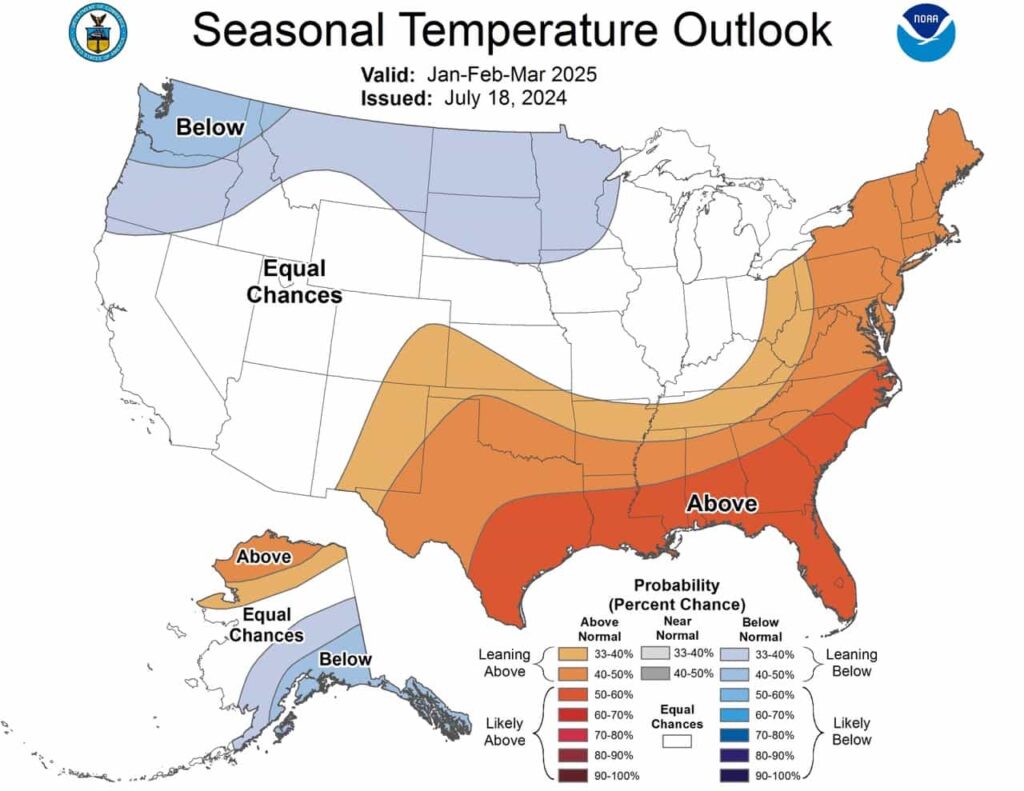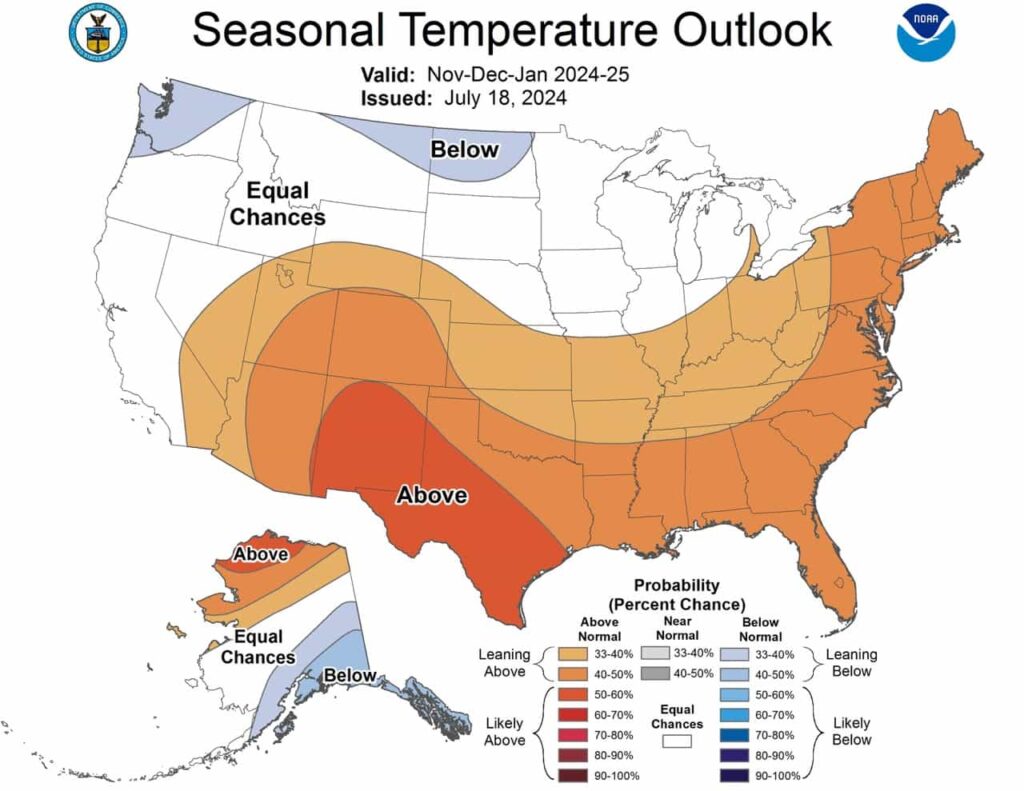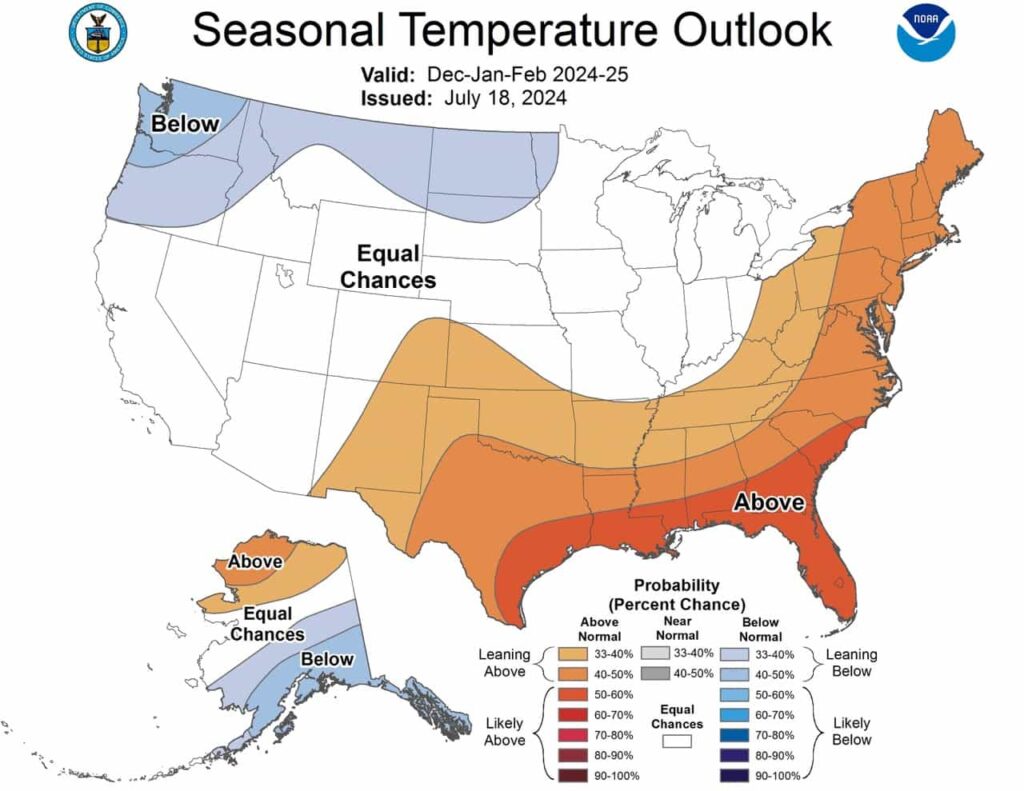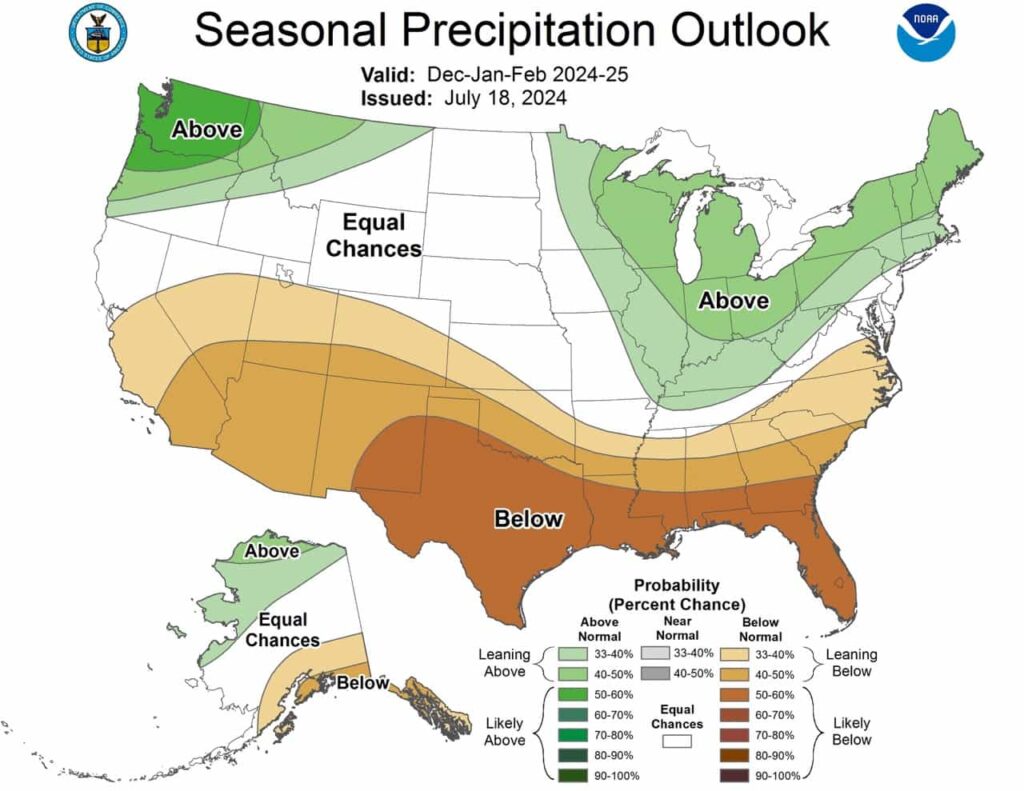July forecast from NOAA for the upcoming winter season
It’s important to note that this is a long-range forecast, and conditions can vary.






Precipitation:
- Pacific Northwest and Northern Rockies: Above-average precipitation expected.
- Northeast and Great Lakes: Higher than normal precipitation likely.
- Southern states and Southwest: Below-average precipitation forecasted.
Snow Likelihood (in order)
- Pacific Northwest (e.g., Mt. Baker, Crystal Mountain): High chance of above-average snowfall.
- Northern Rockies (e.g., Big Sky, Jackson Hole): Good prospects for abundant snow.
- Northeast (e.g., Killington, Stowe): Increased likelihood of significant snowfall.
- Midwest (e.g., Boyne Mountain): Potential for above-normal snow, especially near the Great Lakes.
- Sierra Nevada (e.g., Tahoe resorts): Mixed outlook, with potential for average to slightly below-average snowfall.
- Southern Rockies (e.g., Taos, Telluride): Possibility of below-average snowfall.
- Southwest (e.g., Arizona Snowbowl): Lower chances of significant snow events.
This forecast is based on the expected La Niña pattern, which typically brings wetter and cooler conditions to the northern U.S. and drier, warmer weather to the southern regions. Powderhounds should consider planning trips to the Pacific Northwest, Northern Rockies, or Northeast for the best chances of good snow conditions this winter.
Weather Nerd Discussion:
Prognostic Discussion for Long-Lead Seasonal Outlooks
NWS Climate Prediction Center College Park MD
830 AM EDT Thu Jul 18 2024
SUMMARY OF THE OUTLOOK FOR NON-TECHNICAL USERS
Currently, El Niño Southern Oscillation (ENSO) conditions are neutral with above average sea surface temperatures (SSTs) in the west-central Pacific Ocean, near average SSTs in the east-central Pacific Ocean, and below average
SSTs in the far eastern Pacific Ocean. A La Niña watch is currently in effect and is favored to develop during August-September-October (ASO; 70% chance) and persist into the Northern Hemisphere winter 2024-25 (79% chance) during
November-December-January (NDJ). As summer wanes and winter approaches, the overall temperature and precipitation patterns across the contiguous U.S.
(CONUS) and Alaska are expected to transition to those associated with typical La Niña impacts. For the remainder of summer and early fall 2024 and again late
spring and summer 2025, the overall outlooks resemble long-term decadal trends .
The ASO 2024 Temperature Outlook favors above normal temperatures for much of the contiguous United States (CONUS), with the strongest probabilities reaching
60 to 70% over parts of the Interior West and New England. Above normal temperature probabilities of 50 to 60% are forecast over the Gulf and Southeast
Coasts, including Florida. In contrast, equal-chances (EC) of above-, near-, or below-normal temperatures are favored over the West Coast of CONUS and portions
of the Northern Plains. Below normal temperatures are indicated over southwestern Alaska, transitioning to above normal over the northeast part of
the state.
Below normal precipitation is favored over parts of the western and central CONUS in ASO 2024, except over the West Coast where EC is favored. Above normal
precipitation is forecast for southeastern Texas, the Gulf States, and along the Eastern Seaboard into New England with the highest probabilities (50 to
60%) centered over Florida. Above normal precipitation is also indicated over western Alaska. For the remaining areas of CONUS, EC is forecast.
BASIS AND SUMMARY OF THE CURRENT LONG-LEAD OUTLOOKS
Note: For Graphical Displays of the Forecast Tools Discussed Below See:
http://www.cpc.ncep.noaa.gov/products/predictions/90day/tools/briefing
CURRENT ATMOSPHERIC AND OCEANIC CONDITIONS
ENSO-neutral conditions are currently present in the equatorial tropical Pacific. Observed SST anomalies are -0.2 degrees Celsius in Niño1+2, -0.1 degrees Celsius in Niño3, 0.7 degrees Celsius in Niño4, and 0.3 degrees Celsius in Niño3.4. In general, equatorial SST anomalies are above normal in the western Pacific and below normal in the eastern Pacific. With respect to atmospheric coupling, low-level wind anomalies are easterly over the western equatorial Pacific while upper-level wind anomalies are westerly over the eastern equatorial Pacific. Near to slightly above normal convection is
observed over the western Pacific, as indicated by weakly negative outgoing longwave radiation (OLR) anomalies in that region. Overall, the current ocean-atmosphere coupling is indicative of ENSO-neutral conditions.
Equatorial upper-ocean heat anomalies in the eastern Pacific turned negative in January 2024 and have persisted, strengthening and emerging at the surface from
late winter into spring. Interestingly, the subsurface negative anomalies became less negative during late spring and early summer, currently approximately -0.5 degrees Celsius. Despite the weakening, the negative
anomalies continue to prevail over the eastern half of the equatorial Pacific.
The Madden Julian Oscillation (MJO) is currently weak, with little indication of eastward propagation in fields such as velocity potential and OLR. A robust
stationary Wave-1 structure dominates, whose placement has produced upper level convergence over the Western Hemisphere. This convergence has acted to suppress
tropical cyclone activity despite very warm SST anomalies in the Atlantic basin. Dynamical model guidance of the MJO is mixed, with only the ECMWF hinting at a possible eastward propagation over the coming weeks. Should such a
propagation occur, upper-level conditions will become more favorable for tropical cyclone formation that could impact CONUS.
In the extratropics, coastal SST anomalies are below normal along the western coast of Alaska, with near normal anomalies along Alaska’s southern coast. Near
normal SST anomalies are also observed along the West Coast of CONUS. Along the Gulf Coast and East Coast, SST anomalies are above normal. Current soil moisture anomalies are positive in the Upper Mississippi River Valley and eastern portions of the Northern Plains. They are also positive following the track of the remnants of Hurricane Beryl, particularly in eastern Texas. Large
negative soil moisture anomalies are evident in the southern and central Appalachians. They are also negative in the Northern Rockies and Intermountain
West.
Surface temperatures thus far in July have been characterized by above normal temperatures in western and eastern CONUS, with pockets of near to below normal
temperatures in the Central Plains due to transient cold fronts that have advected in cooler air. This overall pattern looks likely to continue through
the end of July. Interestingly this pattern is reminiscent of the overall long-term warming trend during summer, which is weakest in the north-central
part of CONUS. Precipitation in CONUS has been broadly below normal with a swath of above normal precipitation stretching from the Texas Gulf Coast to
Maine due to Hurricane Beryl. An additional area of above normal precipitation has been observed in the southern Mid-Atlantic region. Temperatures in Alaska
have been much below normal this July due to above normal precipitation caused by troughing and westerly flow into the state.
PROGNOSTIC DISCUSSION OF SST FORECASTS
The Nino3.4 SST consolidation forecast produced by CPC favors a transition to a La Niña state by ASO 2024 with anomalies less than -0.5 degrees Celsius
persisting through February-March-April (FMA) 2025. While forecasted anomalies rebound in the following seasons they are still forecast to remain bounded
between -0.5 and 0 degree Celsius through ASO 2025. Consistent with this forecast, the current ENSO Alert System Status is broadcasting a La Niña Watch
for the winter of 2024-2025 with the CPC Probabilistic ENSO outlook favoring a 70% chance of La Niña emerging by ASO 2024 and a 79% chance of La Niña during
November-December-January (NDJ). With respect to coastal SST anomalies, near to below normal values are forecast by dynamical model guidance to more firmly
establish through winter along the southern coast of Alaska and West Coast, consistent with typical upwelling observed during La Niña.
PROGNOSTIC TOOLS USED FOR U.S. TEMPERATURE AND PRECIPITATION OUTLOOKS
A suite of multiple statistical and dynamical forecast tools is used to produce
the temperature and precipitation outlooks for ASO 2024 to ASO 2025.
Dynamical model forecasts from the Copernicus (C3S) and North American Multi-Model Ensemble (NMME) are used for the first three and six leads respectively, as well as individual model forecasts from the Climate Forecast System version 2 (CFSv2) and European Centre for Medium Range Weather Forecasts (ECMWF) models as available. The objective, historical skill weighted consolidation that combines both dynamical and statistical forecast tools was also considered throughout all leads. The Calibration, Bridging and Merging (CBaM) tool anchored to the NMME forecasts and "bridged" to the Niño3.4 index
is also utilized. In addition to the dynamical model guidance, coastal SSTs and soil moisture anomalies are considered at early leads.
Because La Niña is favored to develop by and persist through winter 2024-25, La Niña impacts are considered the dominant influence on the forecast from ASO
2024 through March-April-May (MAM) 2025. These impacts differ by region, variable, and season. To determine these impacts, La Niña composites and correlations of temperature and precipitation with the Niño3.4 region were employed via statistical tools such as the SST-based Constructed Analog (CA). Long-term decadal temperature and precipitation trends also played a role
during many of the seasons, especially beyond lead 6 when dynamical model guidance is unavailable.
Longer lead outlooks, beginning in April-May-June (AMJ) 2025 are based primarily on decadal temperature and precipitation trends .
PROGNOSTIC DISCUSSION OF OUTLOOKS - ASO 2024 TO ASO 2025
TEMPERATURE
The ASO 2024 Temperature Outlook depicts elevated probabilities of above normal temperatures throughout much of CONUS. The highest probabilities reach 60-70%
north of the Four Corners region and New England where model guidance was in good agreement and decadal temperature trends are strongly positive. Equal
Chances (EC) of above-, near-, or below-normal temperature are posted for the immediate West Coast where coastal SSTs are expected to be below normal,
leading to a potential maritime cooling impact. EC and a slight tilt in the odds toward above normal temperatures are forecast in the more interior regions
of the Pacific Northwest, as La Niña impacts are expected to emerge by late in the season. Farther east, in Northern Plains and portions of the Midwest and
Upper Mississippi River Valley, a combination of pattern persistence, less positive decadal temperature trends , and high climatological variance, particularly in October, has led to regions of EC and reduced odds of above normal temperatures. Furthermore, several models, such as the CFS, also depict a weakness in the temperature field in this region. 50 to 60% probabilities of above normal temperatures are favored along the Gulf Coast, Florida, and the Southeast Coast due to elevated SSTs and model agreement. In Alaska, above normal temperatures are forecast along the eastern North Slope due to decadal trends of sea ice loss. Below normal temperatures are favored in southwestern Alaska and the Aleutians due to below normal SSTs currently observed along with support from the CFS and NMME. Overall confidence in the temperature outlook for ASO 2024 is medium. While August and September generally have low
climatological variance, that is not the case in October, where anomalies in that month can both overwhelm the trend and the combined anomalies in the prior two months. Further uncertainty is introduced due to the potential impact of tropical cyclones, especially in October when they can potentially usher in much cooler air on their western flanks.
The temperature outlooks for September-October-November (SON) 2024 and October-November-December (OND) 2024 generally depict a transition from the summertime state which is dominated by decadal temperature trends toward one that is more typical of La Niña. The overall pattern is consistent with ASO 2024, with the highest probabilities for above normal temperatures in the West
and New England. However, progressing through these seasons, the areas of EC and lower probabilities of above normal temperatures generally expand in the Pacific Northwest, Northern Plains, and Midwest. In fact, a small tilt in the odds toward below normal temperatures is forecast for the extreme northwestern corner of Washington state in OND 2024. The temperature outlook in Alaska increases the odds of above normal temperatures across all of the North Slope and shifts the highest odds of below normal temperatures to the entire southern
third of the state, consistent with a transition to La Niña.
Winter and early spring 2024-2025 temperatures are expected to be driven by La Niña impacts. The forecasts generally tilt the probabilities toward below normal temperatures over the Pacific Northwest and stretching into parts of the Central Plains from NDJ 2024-2025 through MAM 2025, with above normal temperatures over the southern tier of CONUS. For longer leads beginning in AMJ
2025 through ASO 2025, the outlook resembles decadal temperature trends , where above normal temperatures are favored across much of CONUS except parts of the
Northern Plains where trends are weaker and even negative during the spring months. For Alaska, the temperature outlook progressively favors above normal
temperatures over below normal temperatures due to long-term trends and the waning influence of La Nina into the summer months.
PRECIPITATION
The ASO 2024 Precipitation Outlook depicts elevated odds of below normal precipitation over much of the interior of the West, with the highest odds centered over Utah, Colorado, and Wyoming. Probabilities to the south of this
region are relatively muted compared to the previous outlook due to positive precipitation anomalies that have occurred thus far this summer in portions of
Arizona, New Mexico, and southern Colorado. Nonetheless, below normal precipitation is still largely supported by dynamical model guidance such as the NMME, C3S, and CFS along with the growing influence of La Niña and weaker
than normal tropical cyclone activity in the eastern Pacific. A small area of above normal precipitation is favored in the northwestern corner of Washington state as La Niña begins to impact the region later in the season. Along the Gulf Coast and East Coast, above normal probabilities of precipitation are posted consistent with the 2024 Atlantic Hurricane Season Outlook for above
normal tropical cyclone activity. The highest probabilities reach 50 to 60% over Florida. EC is depicted in the remainder of CONUS, due to model
disagreement and no strong decadal trends . Above normal precipitation is slightly favored in western Alaska due to anticipated onshore flow, which is a persistence of the current pattern, and the ECMWF. Overall confidence in the precipitation outlook for ASO 2024 is low to medium. Uncertainty is introduced due to the potential impact of tropical cyclones and their eventual tracks.
The precipitation outlook in ASO 2024 largely persists into SON 2024 before transitioning by winter toward the canonical La Niña precipitation pattern.
This pattern features elevated odds of below normal precipitation along the southern tier of CONUS from southern California to the Southeast. Above normal
precipitation is favored over the Pacific Northwest and Great Lakes. At longer leads, including spring and summer 2025, the La Niña pattern fades and is replaced by large swaths of EC for much of CONUS. Only the Mid-Atlantic and
northern portions of the West have a small tilt in their odds toward above and below normal precipitation, respectively, due to decadal trends . Above normal
precipitation is favored for parts of the North Slope of Alaska, also due to decadal trends , shifting to the southern coast by ASO 2025.
FORECASTER: Cory Baggett


